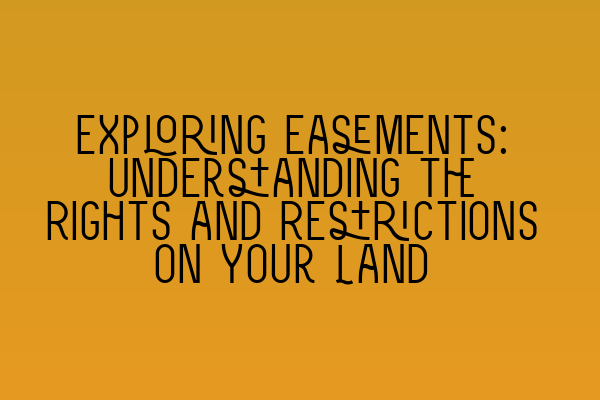Exploring Easements: Understanding the Rights and Restrictions on Your Land
When it comes to property ownership, understanding your rights and restrictions is crucial. One important concept that property owners should be familiar with is easements. Easements are legal rights that allow someone else to use a portion of your land for a specific purpose. Whether you are a property owner or looking to purchase a property, it is essential to have a clear understanding of easements and their implications.
What is an Easement?
An easement is a legal right that allows someone else (known as the easement holder) to use a portion of your land for a specific purpose. This purpose can range from accessing a neighboring property to using your land for utilities or drainage. Easements are typically created by a written agreement or by court order, and they can either be express or implied.
An express easement is created when the easement holder and the property owner agree to the terms and conditions of the easement. This agreement is usually documented in a written contract or deed. On the other hand, an implied easement is created when the circumstances or actions of the parties involved suggest an easement is necessary for reasonable use of the property.
Types of Easements
There are several types of easements that property owners may encounter. Some common types include:
- Right of Way: A right of way easement allows someone to pass through your land to access another property. This type of easement is often used for driveways, footpaths, or access roads.
- Utility Easement: A utility easement grants utility companies the right to access and maintain utility lines, pipes, or other infrastructure on your land. This type of easement is crucial for the proper functioning of utilities such as electricity, water, or gas.
- Drainage Easement: A drainage easement allows for the flow of water across your property to prevent flooding or water damage. This type of easement is common in areas prone to heavy rainfall or where natural drainage routes exist.
- Conservation Easement: A conservation easement is created when a property owner wants to protect their land’s natural or historical features. This easement often places certain restrictions on the property, limiting development or activities that could harm the protected features.
Implications for Property Owners
As a property owner, easements can have both benefits and drawbacks. On one hand, an easement can provide additional income if you receive compensation from the easement holder. Additionally, if your property is landlocked, an easement for a right of way can provide vital access to your property.
However, easements can also restrict your use of the land. For example, a utility easement may prevent you from building certain structures or planting trees in designated areas. It is important to carefully review any existing easements on a property before purchasing or undertaking any major projects.
How to Determine Easements
When buying or assessing a property, it is essential to determine if there are any existing easements. Here are some steps to help you determine easements:
- Review Property Records: Begin by reviewing the property records at the local county recorder’s office. Look for any recorded easements or agreements that may affect the property.
- Obtain a Survey: Hiring a professional land surveyor can help identify any physical markers or indications of existing easements on the property.
- Review Title Insurance: Examine the title insurance policy for any referenced easements or encumbrances that may affect the property’s marketability.
- Consult with a Lawyer: If you have concerns or questions about existing easements or their implications, consult with a qualified property law lawyer who specializes in land law.
Conclusion
Easements are an important aspect of property law that can significantly impact a property owner’s rights and restrictions. Understanding easements and their implications is crucial for both property owners and prospective buyers. By thoroughly researching and reviewing property records, obtaining a professional survey, and seeking legal advice when necessary, property owners can make informed decisions and protect their property rights.
For more information on property law and land law, check out our related articles:
